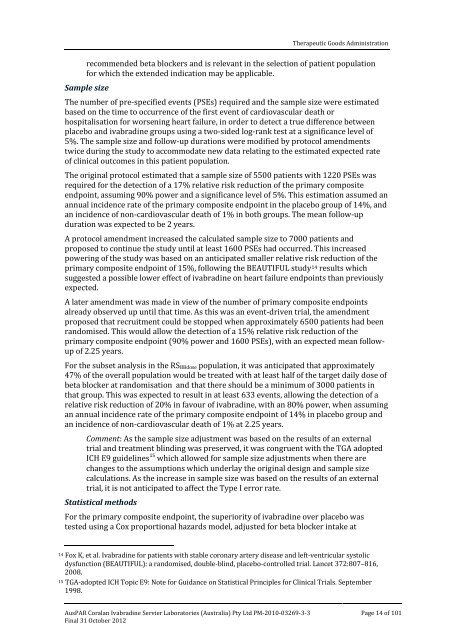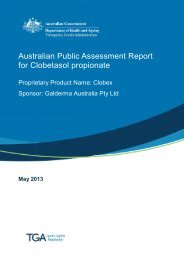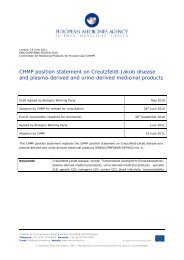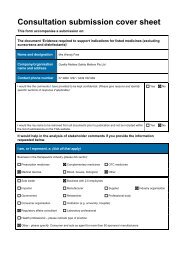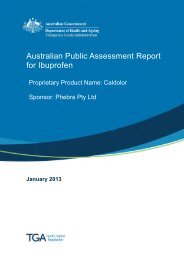AusPAR: Ivabradine - Therapeutic Goods Administration
AusPAR: Ivabradine - Therapeutic Goods Administration
AusPAR: Ivabradine - Therapeutic Goods Administration
Create successful ePaper yourself
Turn your PDF publications into a flip-book with our unique Google optimized e-Paper software.
<strong>AusPAR</strong> Coralan <strong>Ivabradine</strong> Servier Laboratories (Australia) Pty Ltd PM-2010-03269-3-3<br />
Final 31 October 2012<br />
<strong>Therapeutic</strong> <strong>Goods</strong> <strong>Administration</strong><br />
recommended beta blockers and is relevant in the selection of patient population<br />
for which the extended indication may be applicable.<br />
Sample size<br />
The number of pre-specified events (PSEs) required and the sample size were estimated<br />
based on the time to occurrence of the first event of cardiovascular death or<br />
hospitalisation for worsening heart failure, in order to detect a true difference between<br />
placebo and ivabradine groups using a two-sided log-rank test at a significance level of<br />
5%. The sample size and follow-up durations were modified by protocol amendments<br />
twice during the study to accommodate new data relating to the estimated expected rate<br />
of clinical outcomes in this patient population.<br />
The original protocol estimated that a sample size of 5500 patients with 1220 PSEs was<br />
required for the detection of a 17% relative risk reduction of the primary composite<br />
endpoint, assuming 90% power and a significance level of 5%. This estimation assumed an<br />
annual incidence rate of the primary composite endpoint in the placebo group of 14%, and<br />
an incidence of non-cardiovascular death of 1% in both groups. The mean follow-up<br />
duration was expected to be 2 years.<br />
A protocol amendment increased the calculated sample size to 7000 patients and<br />
proposed to continue the study until at least 1600 PSEs had occurred. This increased<br />
powering of the study was based on an anticipated smaller relative risk reduction of the<br />
primary composite endpoint of 15%, following the BEAUTIFUL study14 results which<br />
suggested a possible lower effect of ivabradine on heart failure endpoints than previously<br />
expected.<br />
A later amendment was made in view of the number of primary composite endpoints<br />
already observed up until that time. As this was an event-driven trial, the amendment<br />
proposed that recruitment could be stopped when approximately 6500 patients had been<br />
randomised. This would allow the detection of a 15% relative risk reduction of the<br />
primary composite endpoint (90% power and 1600 PSEs), with an expected mean followup<br />
of 2.25 years.<br />
For the subset analysis in the RSBBdose population, it was anticipated that approximately<br />
47% of the overall population would be treated with at least half of the target daily dose of<br />
beta blocker at randomisation and that there should be a minimum of 3000 patients in<br />
that group. This was expected to result in at least 633 events, allowing the detection of a<br />
relative risk reduction of 20% in favour of ivabradine, with an 80% power, when assuming<br />
an annual incidence rate of the primary composite endpoint of 14% in placebo group and<br />
an incidence of non-cardiovascular death of 1% at 2.25 years.<br />
Comment: As the sample size adjustment was based on the results of an external<br />
trial and treatment blinding was preserved, it was congruent with the TGA adopted<br />
ICH E9 guidelines 15 which allowed for sample size adjustments when there are<br />
changes to the assumptions which underlay the original design and sample size<br />
calculations. As the increase in sample size was based on the results of an external<br />
trial, it is not anticipated to affect the Type I error rate.<br />
Statistical methods<br />
For the primary composite endpoint, the superiority of ivabradine over placebo was<br />
tested using a Cox proportional hazards model, adjusted for beta blocker intake at<br />
14 Fox K, et al. <strong>Ivabradine</strong> for patients with stable coronary artery disease and left-ventricular systolic<br />
dysfunction (BEAUTIFUL): a randomised, double-blind, placebo-controlled trial. Lancet 372:807–816,<br />
2008.<br />
15 TGA-adopted ICH Topic E9: Note for Guidance on Statistical Principles for Clinical Trials. September<br />
1998.<br />
Page 14 of 101


